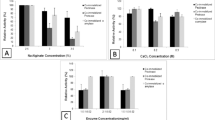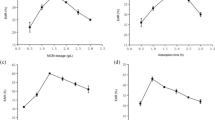Abstract
Pectinase was immobilized on a sodium alginate support using glutaraldehyde and retained 66% activity. The optimal pH for activity shifted from 3.0 to 3.5 after immobilization; however, the optimum temperature remained unchanged at 40°C. The immobilized enzyme also had a higher thermal stability and reusability than the free enzyme, and retained 80% of initial activity after 11 batch reactions.


Similar content being viewed by others
References
Besford RT, Hobson GE (1972) Pectic enzymes associated with softening of tomato fruit. Phytochemistry 11:2201–2205
Busto MD, García-Tramontín KE, Ortega N, Perez-Mateos M (2006) Preparation and properties of an immobilized pectinlyase for the treatment of fruit juices. Bioresour Technol 97:1477–1483
Gotoh T, Matsushima K, Kikuchi K (2004) Preparation of alginate-chitosan hybrid gel beads and adsorption of divalent metal ions. Chemosphere 55:135–140
Hatanaka C, Kobara Y (1980) Determination of glucose by modification of Somogy–Nelson method. Agric Biol Chem 44:2943–2949
Ipsita R, Meryam S, Munishwar NG (2003) Evaluation of a smart bioconjugate of pectinase for chitin hydrolysis. Biochem Eng J 16:329–335
Iwasaki K, Inoue M, Matsubara Y (1998) Continuous hydrolysis of pectate by immobilized endo-polygalacturonase in a continuously stirred tank reactor. Biosci Biotechnol Biochem 62:262–267
Kminkova M, Kucera J (1983) Comparison of pectolytic enzymes using different methods of binding. Enzym Microb Tech 5:204–208
Li TP, Yamauchi R, Kato K (1997) Antibacterial activity of enzymolysate of Haw pectin. J Appl Glycosci 44:489–495
Lozano P, Manjio A, Eomojaro F, Canovas M, Iborraet JL (1987) A cross-flow reactor with immobilized pectolytic enzymes for juice clarification. Biotechnol Lett 9:875–880
Ridley BL, O’Neill MA, Mohnen D (2001) Pectins: structure, biosynthesis, and oligogalacturonide-related signaling. Phytochemistry 57:929–967
Vaillant F, Millan A, Millan P, Dornier M, Decloux M, Reynes A (2000) Co-immobilized pectinlyase and endocellulase on chitin and nylon supports. Process Biochem 35:989–996
Zhu RX, Lin R, Wang JO (1998) Studies on immobilization of pectate lyase with silk fibroin. J Zhejiang Agric Univ 24:74–78 (Chinese)
Acknowledgments
This study was supported by the Tianjin Agricultural University Research Fund (No. 2005005) and by Grant No. 06YFGZNC00300 from the Tianjin Municipal Science and Technology Commission.
Author information
Authors and Affiliations
Corresponding author
Rights and permissions
About this article
Cite this article
Li, T., Wang, N., Li, S. et al. Optimization of covalent immobilization of pectinase on sodium alginate support. Biotechnol Lett 29, 1413–1416 (2007). https://doi.org/10.1007/s10529-007-9409-3
Received:
Revised:
Accepted:
Published:
Issue Date:
DOI: https://doi.org/10.1007/s10529-007-9409-3




